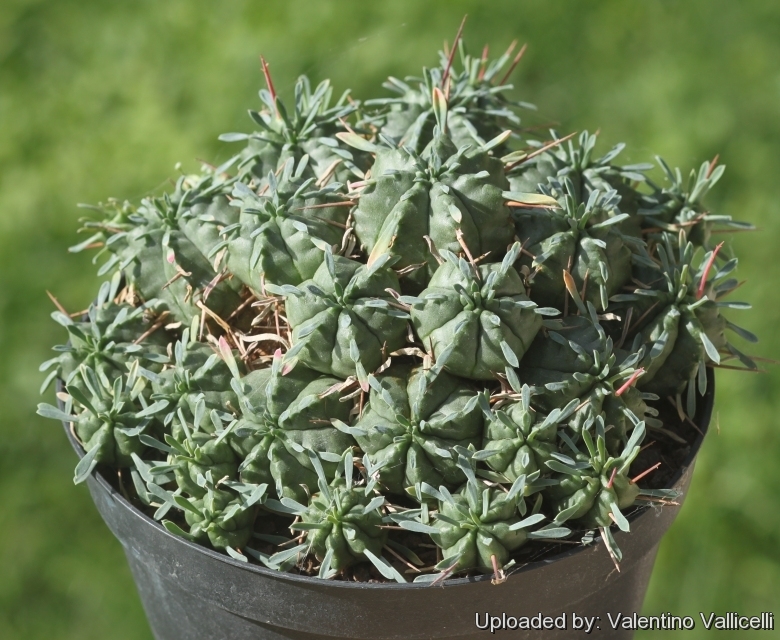
Euphorbia pulvinata cv. Nana (Dwarf form) Photo by: Valentino Vallicelli
Origin and Habitat: Euphorbia pulvinataSN|18705]]SN|18705]] is native to South Africa (Natal), Lesotho. It is located from the south at Queenstown, to the north, through and along Lesotho, the Drakensbergen, Free State and kwazulu Natal up to Zoutpansbergen in the Northern Province, Limpopo, Mpumalanga
Habitat: It grows in predominantly in flat areas on gypseous, limestone or silt plain with a lot of rain, up to 1000 mm per year, and even with snow sometimes.
Synonyms:
See all synonyms of Euphorbia pulvinata
back
Accepted name in llifle Database:Euphorbia pulvinata MarlothTrans. Roy. Soc. South Africa i. 315 (1909)
Cultivars
(1):
back
Common Names include:
ENGLISH: Prickly-leaved Cushion Euphorbia, Pincushion Cactus, Prickly Heaps, Pincushion Euphorbia, Dwarf Pincushion Euphorbia
AFRIKAANS (Afrikaans): Voetangel
ZULU (isiZulu): Inkamamasane, Isihlehle
Description: Euphorbia pulvinataSN|18705]]SN|18705]] is a low-growing clumping dioecious (having distinct male and female specimens) succulent, that in nature forms impressive giant pulvini (cushions), composed of several thousands of little spiny heads. In the ground it makes a striking cushion to up to 1,5 (or more) meters in height and across. Some very old plants must have 40.000 heads or more!!! Sometimes several plants are aggregated into masses up to three meters in diameter. The dwarf type (forma nana) is the most common form in cultivation that has small, compact fat globular heads that seldom exceed 12 cm in height and forms a very dense low cuscion.
Stem: Short, globose, usually 7-angled (but occasionally up to 10 angled), becoming columnar with numerous branches from the base, branches mostly simple, leafless, spiny 2,5-15 cm long, 2,5-3,5(-5) cm thick, very obtusely rounded at the tips with the apex slightly depressed, green, glabrous; angles subacute, slightly crenate, with broad triangular furrows about 2-4 mmdeep between them, which flatten with age
Leaves: Rudimentary, 2-30(-50) mm long, linear-lanceolate, acute, deciduous, leaving small white scars;
Spines (modified sterile peduncles) : White to purple (depending on the season) 1-2 cm long, solitary and irregularly scattered along the angles, usually 1-1,5 cm apart, sometimes more closely placed, with a few minute scale-like bracts scattered along them when young, glabrous.
Subspecies, varieties, forms and cultivars of plants belonging to the Euphorbia pulvinata group
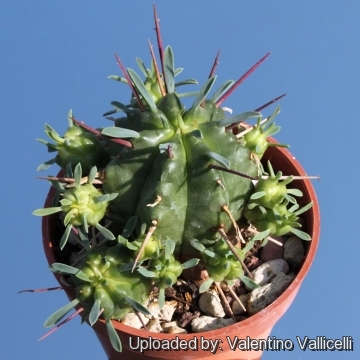 Euphorbia pulvinata cv. Nana (Dwarf form) Photo by: Valentino Vallicelli
Euphorbia pulvinata cv. Nana (Dwarf form) Photo by: Valentino Vallicelli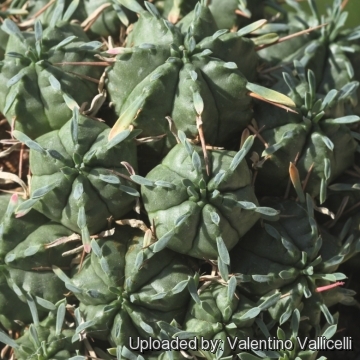 Euphorbia pulvinata cv. Nana (Dwarf form) Photo by: Valentino Vallicelli
Euphorbia pulvinata cv. Nana (Dwarf form) Photo by: Valentino Vallicelli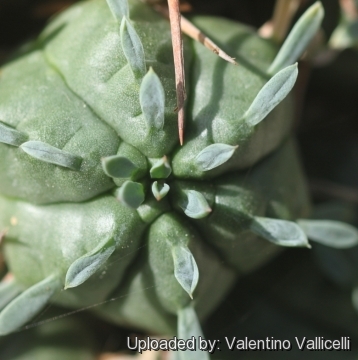 Euphorbia pulvinata cv. Nana (Dwarf form) Photo by: Valentino Vallicelli
Euphorbia pulvinata cv. Nana (Dwarf form) Photo by: Valentino Vallicelli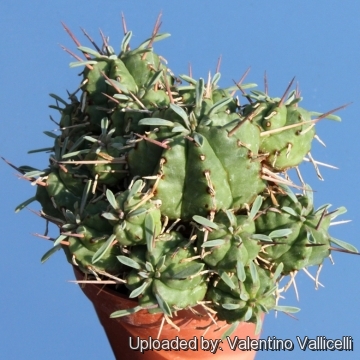 Euphorbia pulvinata cv. Nana (Dwarf form) Photo by: Valentino Vallicelli
Euphorbia pulvinata cv. Nana (Dwarf form) Photo by: Valentino Vallicelli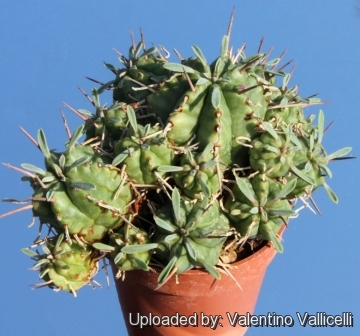 Euphorbia pulvinata cv. Nana (Dwarf form) Photo by: Valentino Vallicelli
Euphorbia pulvinata cv. Nana (Dwarf form) Photo by: Valentino Vallicelli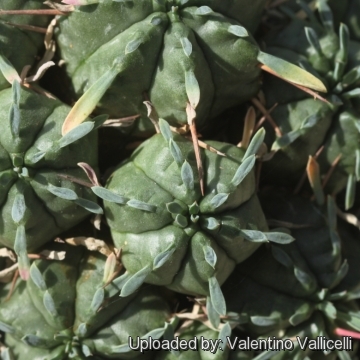 Euphorbia pulvinata cv. Nana (Dwarf form) Photo by: Valentino Vallicelli
Euphorbia pulvinata cv. Nana (Dwarf form) Photo by: Valentino VallicelliCultivation and Propagation: It is a pretty easy species for pot culture. Mature healthy plants are tough, and can also be grown out of doors where frost is not too severe.
Growth rate: It is a relatively rapidly growing species that will make large clumps whit hundreds or even thousands heads given the best conditions.
Soil: It grows well in a very draining mineral potting substrate, but it isn't picky about soil.
Repotting: Use pot with good drainage.
Watering: The area where this plant is native receives rain both in winter and summer, so it can be watered moderately all year around (except in the coldest month of the winter as it rots easily, especially if over wet ). During the summer they enjoy average watering, but do not overwater (Rot prone).
Fertilization: Feed with a high potassium fertilizer in summer.
Hardiness: When dormant, the plant is very cold tolerant (down to nearly -9° C or less), but when left out it is more sensitive to frost.
Exposure: They do need a lot of light to keep their compact growth-form, but different clones vary in their tolerance of full sunshine. However some protection in light shade is recommended during the hottest hours in summer.
Uses: It is an excellent plant for container growing. It always looks good and stays small. It looks fine in a cold greenhouse and frame.
Warning: As with all other Euphorbias when a plant get damaged it exudes a thick white milky sap known as latex. This latex is poisonous, and may irritate skin. Pay extreme attention not to get any in your eyes or mouth.
Cultivated plants must be handled carefully.
Rot: Rot it is only a minor problem with Euphorbias if the plants are watered and “aired” correctly. If they are not, fungicides won't help all that much.
Propagation: It is propagated by cuttings (It branches enthusiastically, and offsets are readily available). If you remove an offset, remember to let it dry for some days, letting the wound heal (cuttings planted too soon easily rot before they can grow roots). Lay it on the soil and insert the stem end partially into the substrate. Try to keep the cutting somewhat upright so that the roots are able to grow downward. It is better to wash the cut to remove the latex.
Your Photos
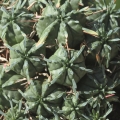
by Valentino Vallicelli


















